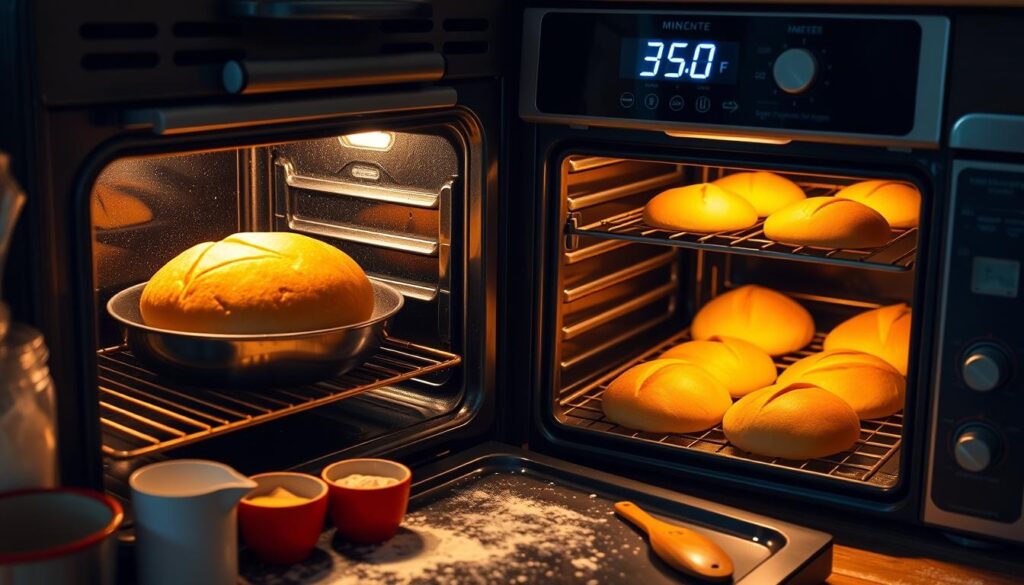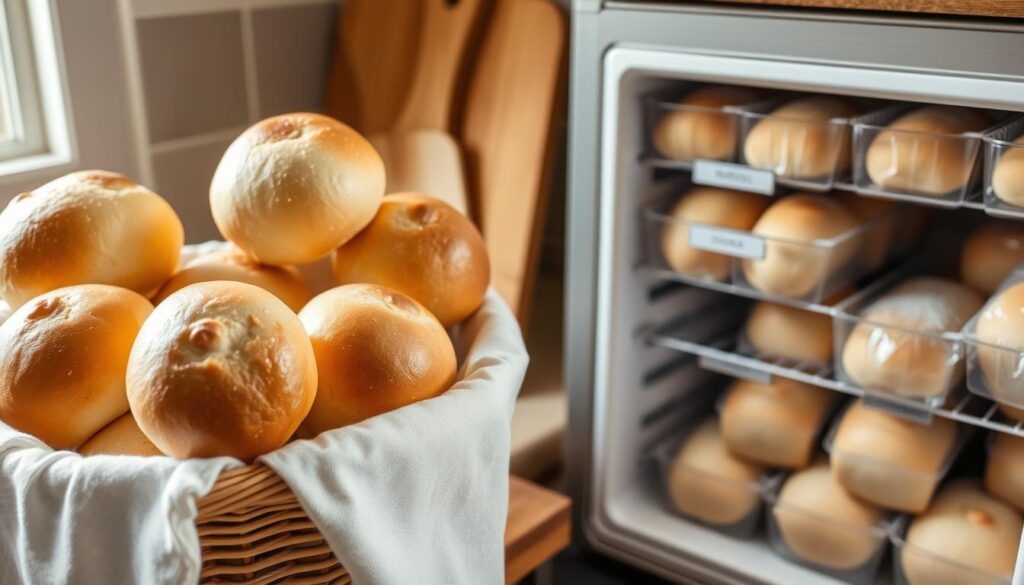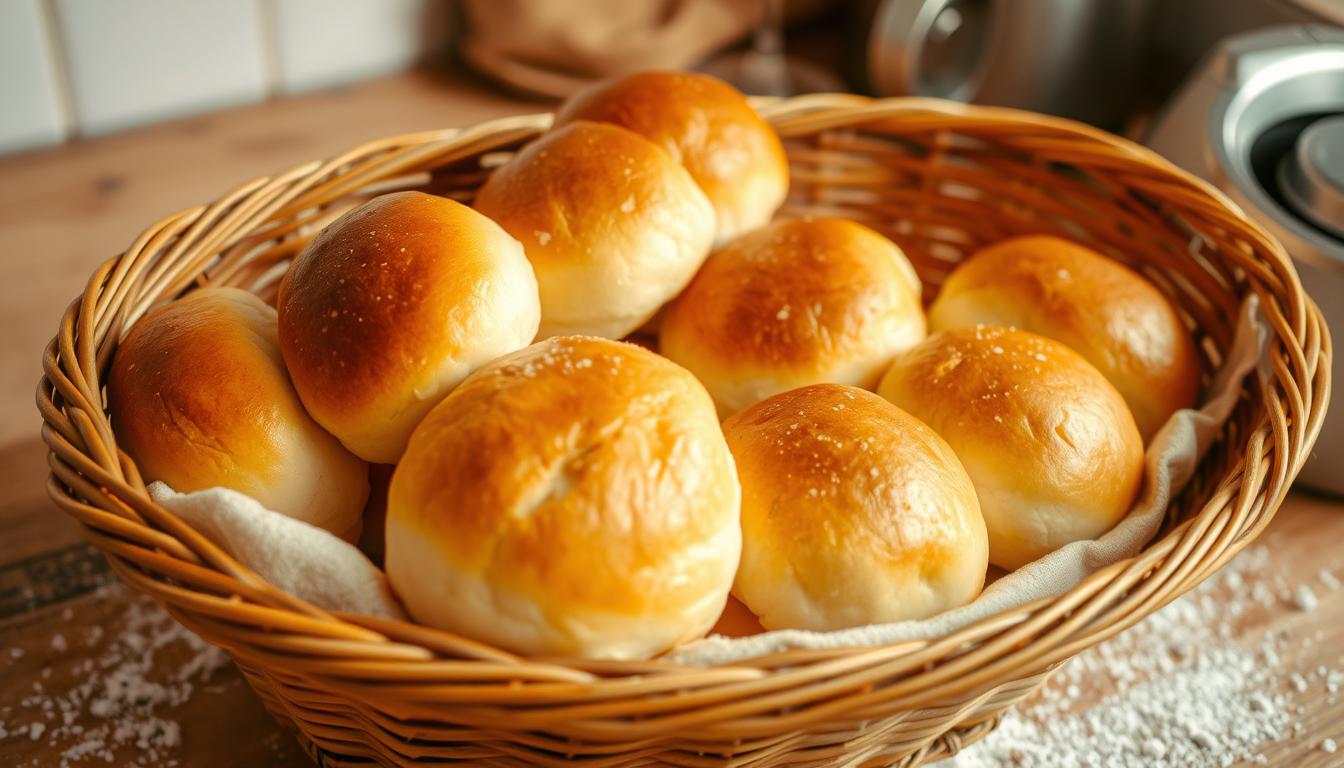bread roll : Every Sunday morning, my grandmother’s kitchen was filled with the smell of freshly baked bread rolls. These soft, fluffy rolls were more than just food. They were memories waiting to be enjoyed. Now, I’m excited to share a recipe that turns simple ingredients into golden, soft delights.
Making soft bread rolls is more than cooking. It’s about creating moments of comfort. With just a few hours and basic ingredients, you can make your kitchen smell like a bakery. These homemade bread rolls are great for weeknight dinners, holiday gatherings, or just enjoying a warm treat.
bread roll : Key Takeaways
- Bread rolls take approximately 3 hours and 40 minutes to prepare
- Recipe yields 12-15 delicious rolls
- Perfect for both busy weeknights and special occasions
- Minimal ingredients required
- Can be stored at room temperature for 2-3 days
- Freezer-friendly for up to 3 months
- Nutritious with balanced macronutrients
bread roll : Essential Ingredients for Perfect Homemade Rolls
Making delicious bread rolls starts with the right ingredients. Your baking success depends on choosing high-quality ingredients that work well together.
The key to great bread rolls is choosing the right parts. Let’s look at the essential ingredients that turn simple items into tasty rolls.
Pantry Staples for Bread Rolls
- All-purpose flour for bread rolls: 3-4 cups
- Active dry yeast: 1 package (¼ ounce)
- Warm milk: 1¼ cups
- Melted butter: 5 tablespoons
- Sugar: 2 tablespoons
- Salt: 1 teaspoon
bread roll : Quality Ingredients Make the Difference
Not all ingredients are the same. Fresh, high-quality flour can make a big difference. Good ingredients mean better taste.
« Baking is a science, and each ingredient plays a crucial role in creating the perfect texture and flavor. »
Selecting the Right Yeast
Yeast is the magic that makes dough rise. Choose active dry yeast and make sure it’s fresh. The best temperature for activating yeast is 110-115°F.
| Yeast Type | Activation Time | Best Use |
|---|---|---|
| Active Dry Yeast | 5-10 minutes | Traditional bread rolls |
| Instant Yeast | Immediate | Quick baking projects |
Remember, exact measurements and room temperature ingredients are crucial. They help make soft, fluffy bread rolls that will wow your family and friends.
bread roll :The Science Behind Soft and Fluffy Bread Rolls
Learning about bread roll texture turns baking into a precise art. Gluten development is key to making soft rolls. When kneading, you stretch and align protein strands, building the bread’s structure.
Yeast fermentation brings your bread rolls to life. Tiny microorganisms eat sugars and make carbon dioxide. This creates air pockets, making your rolls light and airy.
« Baking is a science, and bread rolls are your delicious experiment. » – Professional Baker
Several factors affect bread roll texture:
- Protein content in flour
- Kneading technique
- Fermentation temperature
- Resting time
For yeast fermentation, you need:
- Temperature between 105-110°F
- Humidity control
- Proper sugar activation
- Adequate resting period
By mastering these scientific principles, your bread rolls will always be soft and fluffy.
bread roll : Step-by-Step Mixing and Kneading Process
Making perfect bread rolls begins with mixing ingredients and getting the dough right. The mixing and kneading steps are key for the texture and taste of your homemade rolls.
Learning to knead dough takes time and effort. You can choose from two main ways to make your dough.
Hand Mixing Method
Here’s how to mix by hand:
- Start by mixing dry ingredients in a big bowl
- Make a well in the center for the wet ingredients
- Slowly add ingredients until a rough dough forms
- Knead on a floured surface for 10-12 minutes
Stand Mixer Approach
Using a stand mixer makes kneading easier:
- Attach the dough hook
- Mix on low speed for 2-3 minutes
- Switch to medium speed for 4-5 minutes
- Look for dough that’s smooth and elastic
« The secret to perfect rolls is understanding your dough’s texture and knowing when to stop kneading. » – Professional Baker
Proper Kneading Techniques
Check your dough with these tests:
- Windowpane test: Stretch a small dough piece – it should be thin and clear without breaking
- Dough should bounce back when pressed gently
- Its surface should look smooth and elastic
Getting the dough just right takes practice. Don’t worry if it’s not perfect the first time!
bread roll Critical Rising Times and Temperature Guidelines
Understanding how bread dough rises is key to making perfect bread rolls. Yeast needs the right temperature and timing to turn simple ingredients into fluffy, tasty rolls. Paying close attention to the proofing process is essential for the best texture and flavor.
Temperature is very important for bread dough rising. The best temperature for yeast activation is between 75°F to 78°F (24 to 25°C). Your kitchen’s temperature greatly affects how fast and well your dough will rise.
« Temperature is the secret language of bread dough » – Professional Baker’s Insight
Proofing Time Recommendations
- First rise: 1-2 hours until dough doubles in size
- Second rise after shaping: 30-60 minutes
- Warm environments accelerate rising
- Cooler temperatures slow down fermentation
Temperature Impact on Fermentation
| Temperature Range | Proofing Duration | Dough Characteristics |
|---|---|---|
| 80°F (26°C) | 1-2 hours | Rapid fermentation |
| 74-76°F (23-24°C) | 2-4 hours | Moderate development |
| 39°F (4°C) | 10-16 hours | Slow, controlled rise |
Look for signs of proper rising: the dough should feel light, airy, and spring back when gently pressed. Avoid over-proofing, which can cause the dough to collapse and lose its structure.
Professional bakers suggest using a kitchen thermometer to check dough temperature accurately. If your kitchen is cooler, create a warm spot near a preheated oven or use a proofing box to keep temperatures steady.
Shaping Your Bread Roll Dough
Making uniform bread rolls needs precision and skill. Shaping the dough turns it into beautiful, consistent spheres. These will wow your guests at any meal.
Knowing the right shaping techniques is key when working with bread roll dough. Getting uniform rolls starts with the right portioning and handling.
Rolling Techniques for Perfect Spheres
To make perfectly round bread rolls, follow these steps:
- Divide your dough into equal portions using a bench scraper
- Gently round each piece into a smooth ball
- Use a light touch to avoid deflating the dough
- Create tension by rotating the dough on the work surface
Bread Roll Size and Spacing Guidelines
The size of your bread rolls depends on your recipe and baking dish. Professional bakers usually make 15-24 pieces for even results.
| Baking Dish | Roll Quantity | Individual Roll Weight |
|---|---|---|
| LloydPans 10×2.25-inch round pan | 14 rolls | 85 grams |
| USA Pan 8-inch square pan | 16 rolls | 65 grams |
| Nordic Ware Half Sheet | 5 hamburger buns | 120 grams |
« A tight outer skin on the shaped dough is essential for maintaining its form during baking. » – Bread Shaping Expert
Pro tip: Chill sticky dough for 15 minutes to make shaping easier. This method helps achieve a smooth, even surface without extra flour.
Baking Temperature and Timing Secrets

Baking bread rolls needs precision in oven temperature and timing. The right temperature can turn a good result into an amazing one.
The best oven temperature for bread rolls is between 375°F and 425°F. This range helps your rolls get a golden-brown crust and stay soft inside. Always preheat your oven fully before baking the rolls.
« Perfect bread rolls are a delicate balance of heat and time. » – Artisan Baker’s Wisdom
Here’s a detailed guide to baking bread rolls:
- Preheat oven to 425°F
- Bake for 20-25 minutes
- Look for deep golden-brown color
- Check internal temperature reaches 190°F
Baking time can change based on roll size. Smaller rolls might need 20 minutes, while bigger ones could take 25-27 minutes. Follow these tips for perfectly baked bread rolls every time.
Oven Performance Tracking
| Roll Size | Baking Temperature | Baking Time |
|---|---|---|
| Small Rolls | 425°F | 20 minutes |
| Medium Rolls | 425°F | 22-23 minutes |
| Large Rolls | 425°F | 25-27 minutes |
Pro tip: Always use an instant-read thermometer to ensure your bread rolls reach the perfect internal temperature of 190°F.
Professional Tips for Golden-Brown Crust
Getting the perfect bread roll crust is all about precision and expert techniques. The journey to golden-brown rolls starts with understanding the art of surface preparation and finishing.
Professional bakers know the secret to a stunning crust. It’s all about strategic preparation and application techniques.
Butter Wash Mastery
Your butter wash can turn ordinary bread rolls into bakery-quality masterpieces. The right way to apply it makes a big difference in the crust’s look and taste.
- Use room temperature unsalted butter for smooth application
- Brush gently to avoid deflating the delicate roll surface
- Apply butter wash immediately after removing rolls from the oven
Creating the Perfect Finish
A consistent golden-brown crust needs attention to several factors during baking.
| Technique | Impact on Crust | Recommended Action |
|---|---|---|
| Oven Temperature | Controls browning intensity | Preheat to 425°F |
| Steam Creation | Enhances crust development | Add ice cubes to bottom of oven |
| Flour Dusting | Prevents sticking | Use 50% rice flour blend |
The art of creating golden-brown rolls is a delicate balance of temperature, technique, and timing.
Mastering butter wash and finishing techniques will make your homemade bread rolls extraordinary. The key is to practice often and pay attention to small details in your baking.
Make-Ahead and Storage Solutions

Learning how to store bread rolls can make your life easier. You can enjoy fresh bread any time you want. It’s great for busy weeks or when you need homemade rolls.
Freezing bread dough offers several options. Here are some important tips:
- Fresh dough can be refrigerated for up to 24 hours before baking
- Shaped rolls can be frozen for extended storage
- Baked rolls remain good in the freezer for up to 3 months
For effective freezing, follow these steps:
- Wrap individual rolls tightly in foil
- Place wrapped rolls in an airtight freezer bag
- Label with the date of preparation
Reheating bread rolls needs care to keep them soft. Pro tip: Always reheat frozen rolls in foil at 300°F for about 10 minutes. This brings back their fresh-baked taste and warmth.
« Proper storage is the secret to enjoying homemade bread rolls any time! » – Baking Enthusiast
Another option is storing rolls at room temperature. Freshly baked rolls can stay tasty for 2-3 days in an airtight container. But, bread is best eaten within the first day.
Common Troubleshooting for Bread Roll Problems
Baking bread rolls at home can be tricky. Knowing the common issues helps make perfect, fluffy rolls. About 30% of baking failures come from simple mistakes that can be fixed.
Dealing with dense bread rolls and rising issues needs careful attention. Let’s look at the most common problems you might face.
Identifying Dense Roll Culprits
Dense bread rolls come from a few main causes:
- Expired or inactive yeast (affects over 25% of home bakers)
- Incorrect water temperature
- Over-kneading the dough
- Using low-protein flour
Solving Bread Not Rising Effectively
If your bread isn’t rising, try these steps:
- Check yeast freshness – verify the expiration date
- Ensure water temperature is between 110°F to 115°F
- Confirm rising environment temperature (85°F to 95°F is ideal)
| Problem | Potential Cause | Solution |
|---|---|---|
| Flat Rolls | Expired Yeast | Replace with fresh yeast |
| Tough Texture | Over-kneading | Reduce kneading time |
| No Rising | Cold Temperature | Warm rising environment |
Pro tip: Always proof your yeast before starting to ensure it’s active and ready to help your dough rise perfectly.
By learning these troubleshooting tips, you’ll see big improvements in your baking. Remember, the more you practice, the better you’ll get!
Delicious Variations and Flavor Additions
Turn your basic bread roll recipe into a fun adventure. Flavored bread rolls can make any meal special. They offer endless chances to try new things in your kitchen.
Exploring herb and cheese bread rolls brings a world of tasty experiences. Here are some delicious options to excite your taste buds:
- Garlic and Herb Rolls: Mix in fresh rosemary, thyme, and garlic
- Cheese Lover’s Rolls: Add cheddar, parmesan, or mozzarella to the dough
- Mediterranean-Inspired Rolls: Use sun-dried tomatoes and feta cheese
- Spicy Jalapeño Rolls: Add diced jalapeños and sharp cheddar for a spicy kick
When making flavored bread rolls, keep these tips in mind:
- Add herbs and spices early in the mixing process
- Put in cheese just before kneading
- Adjust the liquid to keep the dough right
« The secret to amazing bread rolls is creativity and careful ingredient balance. » – Professional Baker
Adding herbs and cheese can make your bread rolls healthier. These ingredients can increase vitamins and minerals by 20-30%.
| Variation Type | Key Ingredients | Flavor Profile |
|---|---|---|
| Herb Bread Rolls | Rosemary, Thyme, Parsley | Earthy, Fresh |
| Cheese Bread Rolls | Cheddar, Parmesan, Mozzarella | Rich, Tangy |
| Garlic Bread Rolls | Fresh Garlic, Herbs | Bold, Aromatic |
Pro tip: Always experiment and have fun creating your unique bread roll variations!
Conclusion
Making homemade bread rolls is more than a recipe. It’s an art that turns simple ingredients into warm comfort food. Your journey has given you key bread making tips. These tips make any meal special.
The process might seem hard at first. But with practice, you’ll get better at making perfect rolls. You’ll learn about yeast and kneading, growing more confident in your baking.
Great homemade bread rolls come from passion, patience, and practice. They make any dinner special, whether for family or guests. Feel free to try new things like herbs or cheese in your rolls.
We encourage you to keep exploring bread baking. Share your wins, learn from your tries, and enjoy making something special with your hands.

